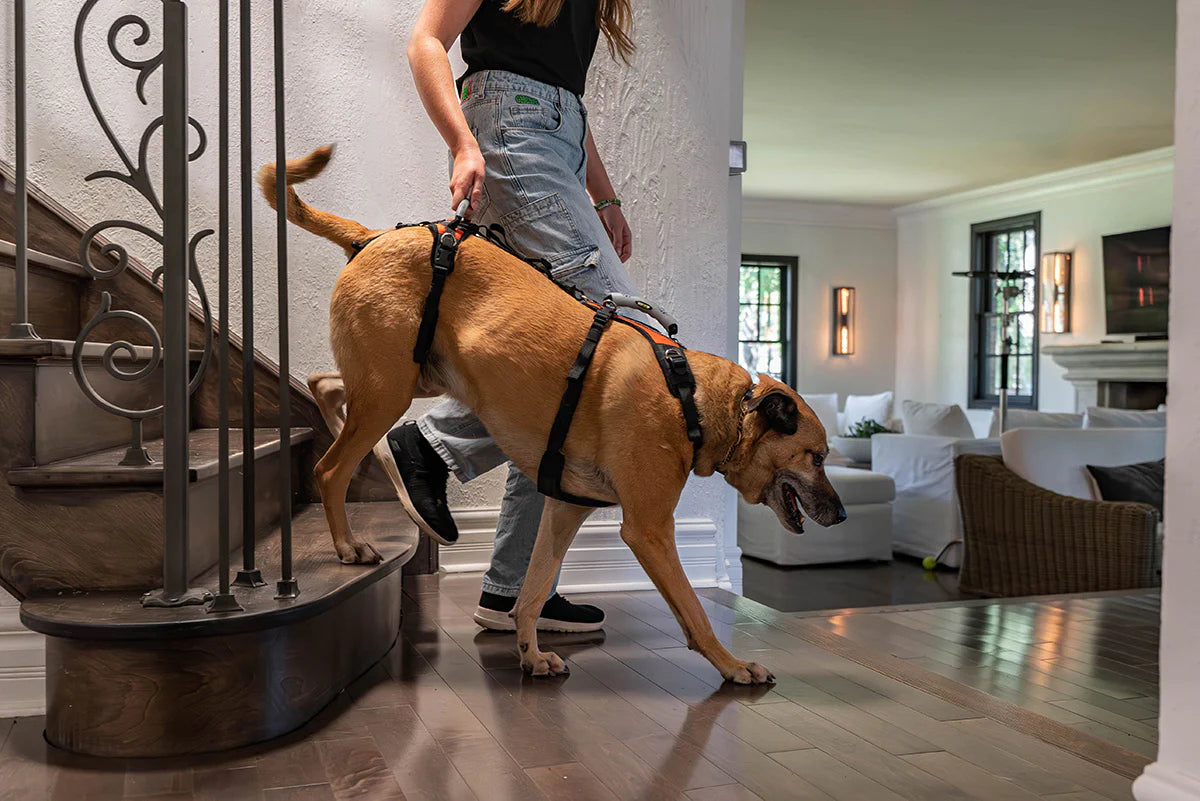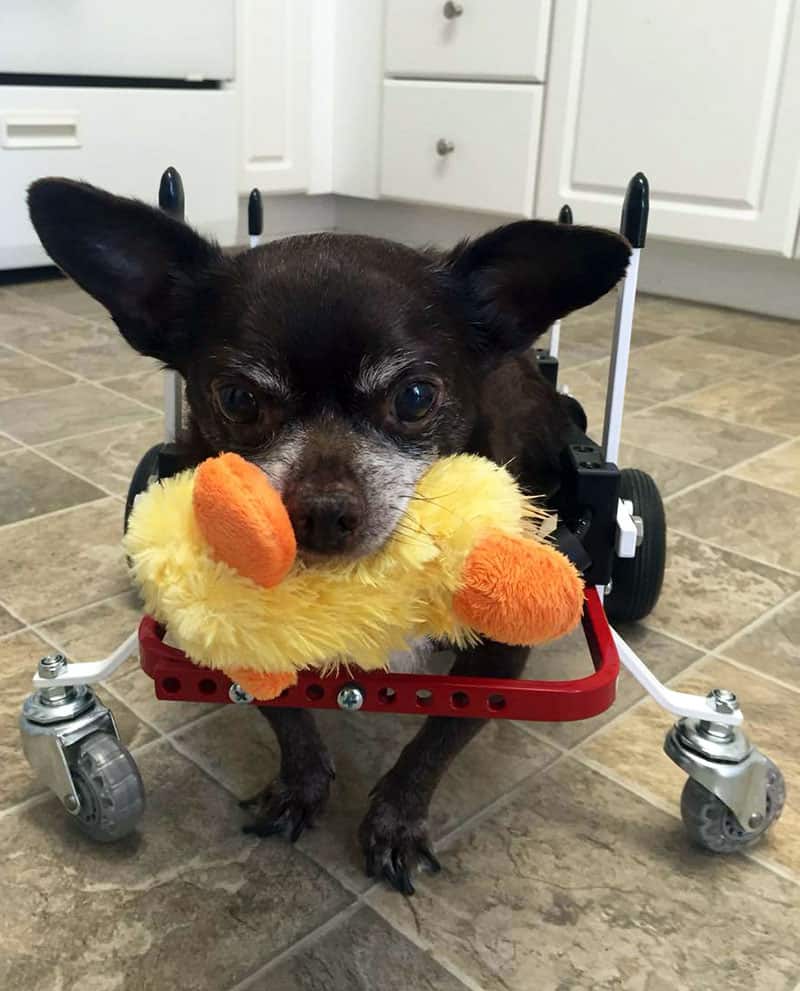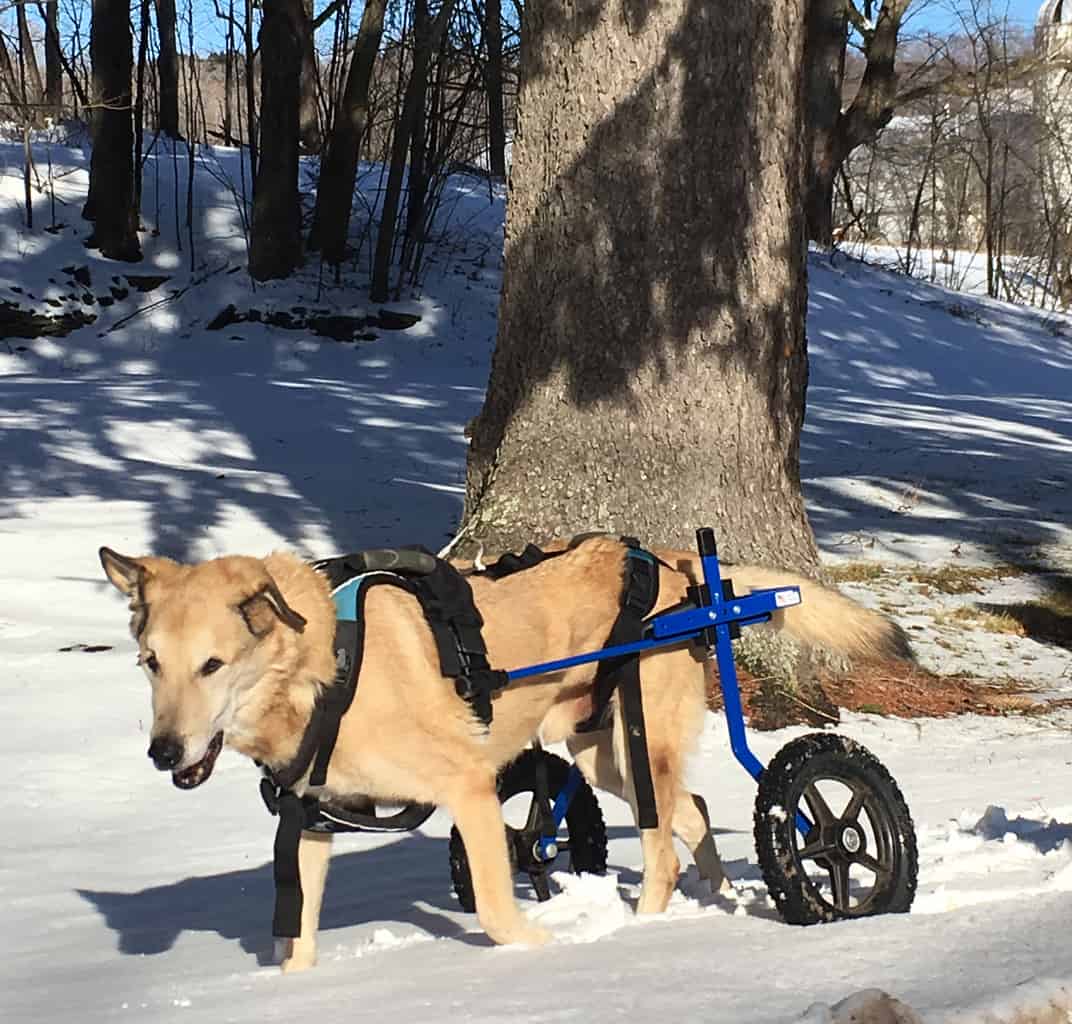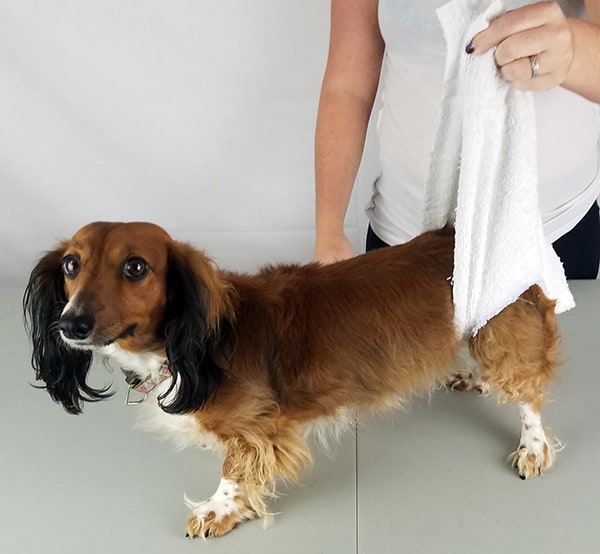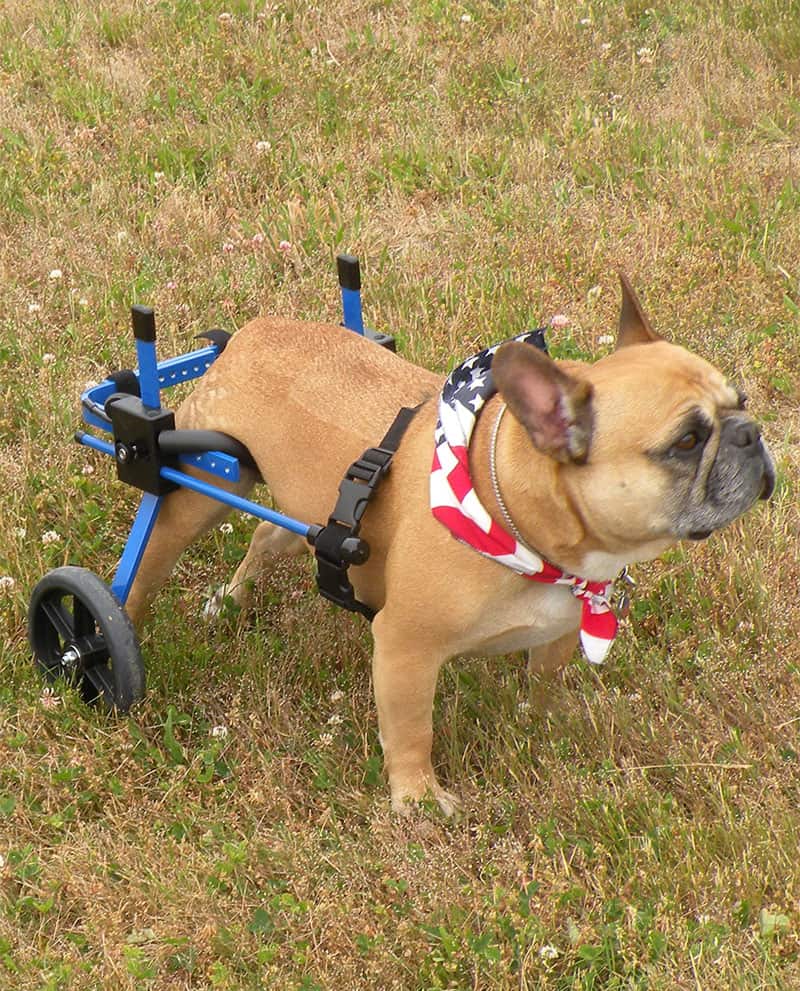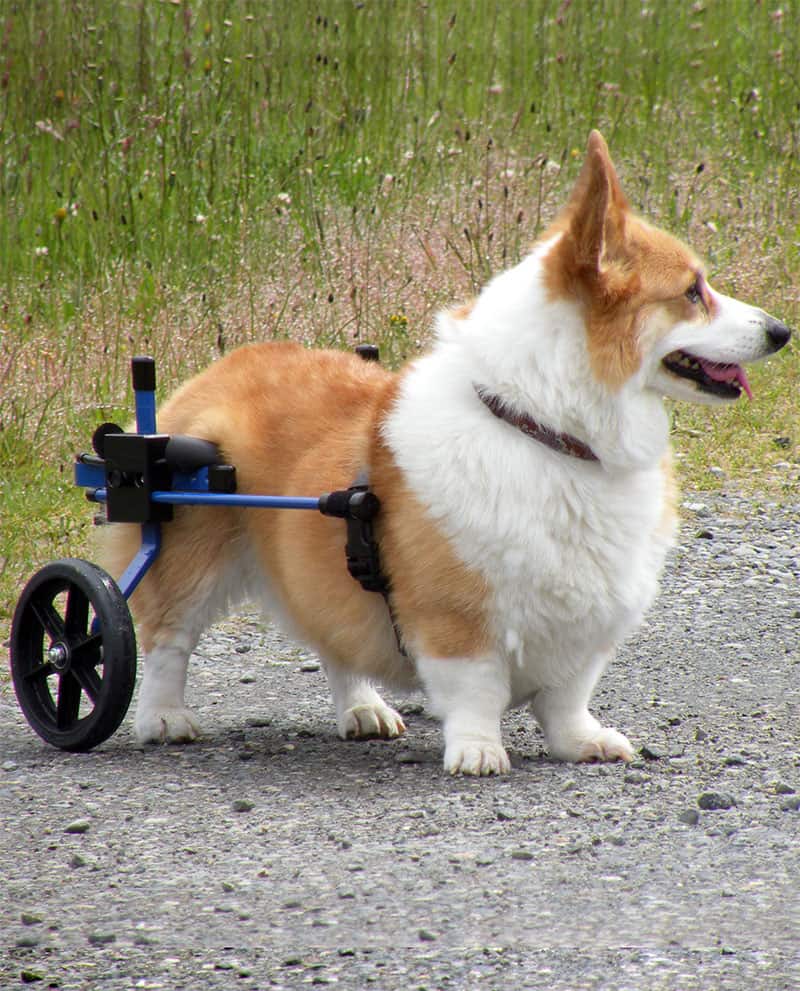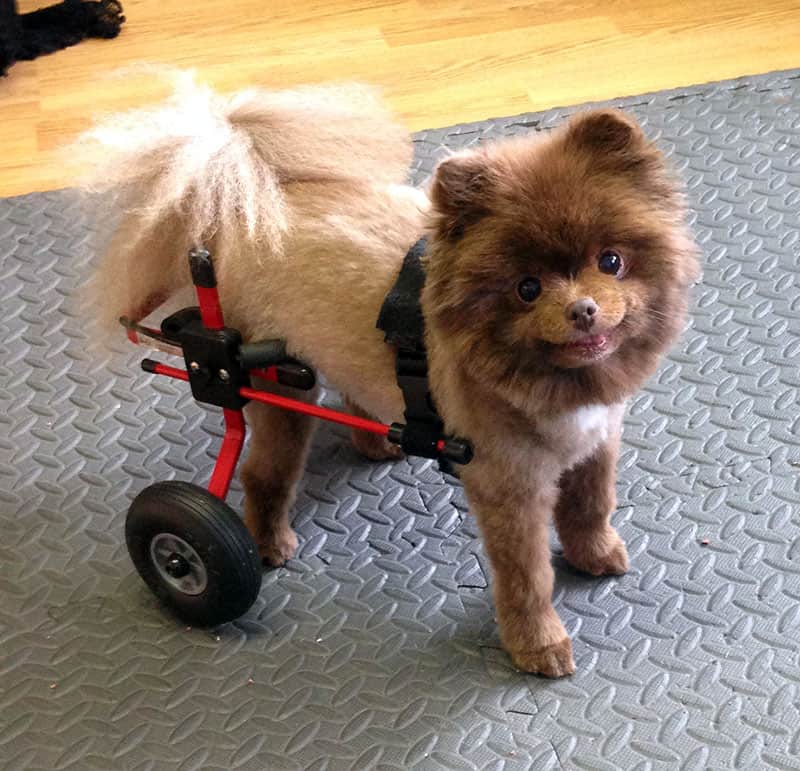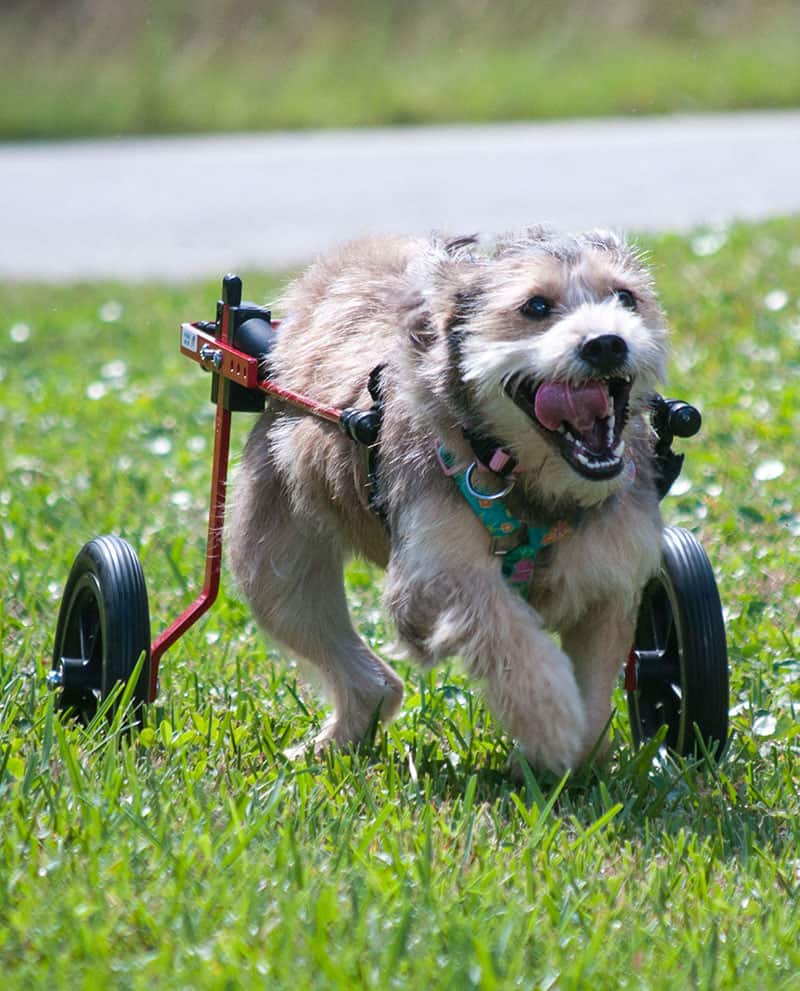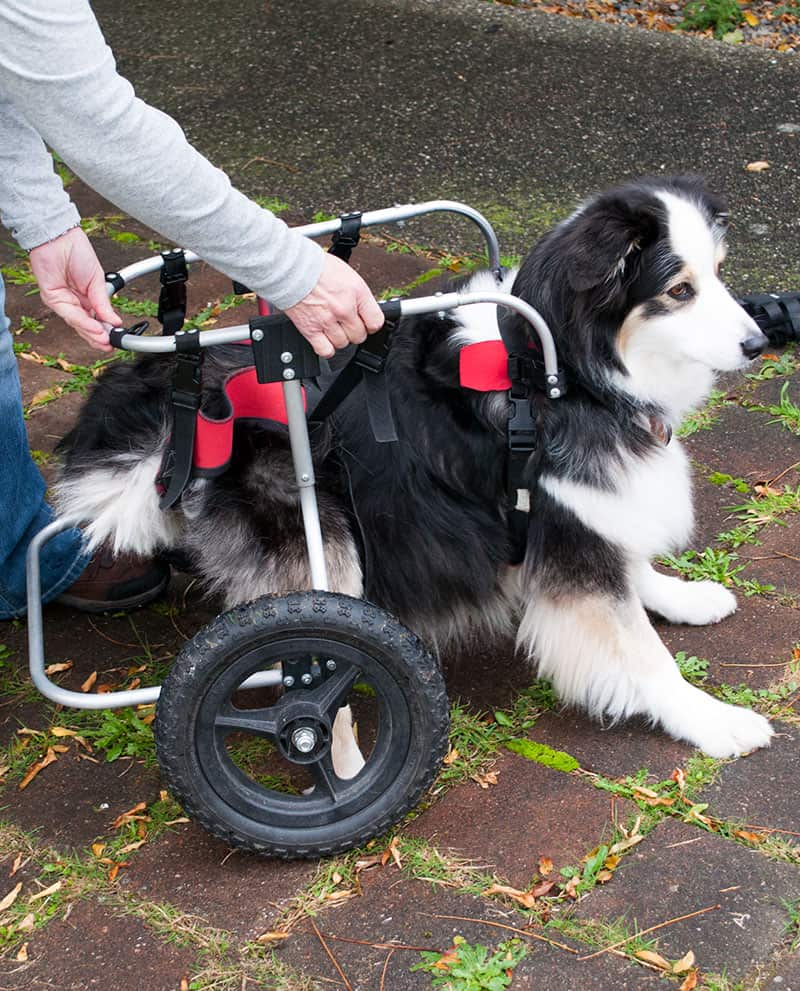Resources
How Do Other Pets Get Along with Dogs in Wheelchairs?
So your dog needs a wheelchair, but you have other pets. You might be worried that your other companions will act strangely around the dog with the disability, or get outright hostile.
Don’t worry: that’s not very likely. We frequently build wheelchairs for dogs who have a pack—and the packs' humans have told us that all the other animals get along fine.
This post covers cats and other dogs, since they’re the animals most likely to encounter a dog in a wheelchair. Check with your vet if you take care of a different animal.
How Dogs in Wheelchairs Get Along with Other Dogs
Dogs are remarkably perceptive about the condition of the dogs in their pack. They’ll notice if one of the pack has a disability, and what the pack needs to do to accommodate it.
“[Dogs] all get it—it’s really interesting,” Patricia Denys says.
Denys’s dog, Andy, is a Bichon mix. He’s six years old, and he’s had his wheelchair for a few years. Denys’s other dogs get along fine with Andy. She says they’re patient when Andy gets ready for the day.
“If we’re going outside or somewhere, the cart comes out first for Andy,” Denys says. “The rest of the dogs know that, and they see the day starting.”
The rest of the pack even keeps it together when Andy is getting ready for his walk!
“While we put him in the cart, [the rest of the dogs] have to wait, but they’re patient.”
So dogs in the same pack get along fine when a packmate gets a wheelchair. However, dogs that haven’t met your dog might have a bad reaction. You’ve probably met dogs at the dog park who get upset when they meet a dog wearing a vest or harness. That kind of dog will react the same way to a dog in a wheelchair.
How Dogs in Wheelchairs Get Along with Cats
Cats are very particular. (You may have noticed.) So they might be skeptical of the cart when you bring it home. Expect lots of sniffing.
But it’s most likely that your cat will get used to the wheelchair. That’s what happened with Denys’s cats. After the initial skepticism, your cat will continue to enjoy a good relationship with your dog—or the opposite of that, if your dog and cat have never gotten along.
We can help your dog with a disability get around again, but we can’t convince cats to do anything they don’t want to. Nobody can.
Which Dog Wheelchair Design Should I Choose?
Our dog wheelchair is fully convertible. Therefore, if your pet needs more or less support, parts can be added or subtracted to make sure it is the correct support system that your pet needs at its particular stage of mobility loss.
The basic standard two wheel cart is for the pet that has lost, or is losing, its ability to walk with the rear legs, but is still strong in the front legs. This orthopedically designed cart gives total support to the rear, keeping the spine and body in alignment, while taking stress off the front legs.
This K9 cart may be used either with the legs up and protected in padded slings, or with the legs down on the ground enabling the pet to walk on its paw or paws. If your pet is able to walk with one hind leg only, then we suggest covering the paw that is not functional with a protective boot.
Strength in the front legs is important for the standard 2 wheeled cart. A pet dragging itself around is not an indication of forelimb strength as a pet will drag itself from A to B just to get there. Unfortunately, dragging itself around is weakening causes the front legs to weaken, and places strain on its body. The longer it goes without mobility help, the weaker your pet will become in the front legs, at which point they may not be able physically to handle the standard two wheeled dog wheelchair.
We suggest making up a handheld sling to test the front leg strength. Take an old towel or piece of material, cut two holes in it for the rear legs to go down through, and then holding the ends of the towel and keeping the back level make sure that your pet is able to walk well on the front legs.
If you have any doubt at all, or need questions answered, please call us and we will advise as to whether this design cart is suitable for your pet.
When Does A Dog Need A Wheelchair?
Seeing your dog lose partial or complete mobility is not easy for any owner. Whether the condition is due to an injury or permanent paralysis, it’s never fun watching a pet struggle.
Luckily, despite the unfortunate turn of events, your dog still appears to be generally happy. Sure, your dog may have a hard time running or using the stairs. But in general, he or she appears responsive, alert, and, most importantly, motivated to be active.
If you find yourself relating to this situation but are unsure if your dog’s condition is severe enough for a wheelchair, then you have come to the right place!
General Guidance:
Consult your vet: If you notice your dog is experiencing any signs of mobility issues, don’t wait to talk to the vet. Although some conditions are easily managed, others may lead to chronic problems if they are not addressed in a timely manner.
At-home evaluations: If you believe that a wheelchair is the best next step, try the “towel test” to see if the dog has enough strength to support itself by its forelimbs.
Mobility issues can be caused by:
Soreness
General weakness of the limbs
Accidental injuries
Surgery recovery
Spinal problems
Paralysis
Arthritis
Amputations
Neurological issues
Aside from the mobility issues listed above, here are five specific conditions that could mean your pet will benefit from a dog wheelchair:
Intervertebral Disc Disease (IVDD)
If your dog has IVDD, a wheelchair could be the best recovery option. IVDD is a common condition, caused by displacement or deterioration of the cushion between spinal discs. Although some dogs are more prone to developing IVDD than others, this uncomfortable and often painful disease can affect all dogs. Depending on the degree of damage, weakness or paralysis of the legs may occur.
Depending on the severity and the stage in which IVDD is discovered, your dog may still maintain full usage of all four legs. In the early stages, a wheelchair would be useful for rehabilitation. If, however, the damage is too severe and your dog becomes paralyzed, the wheelchair would become a tool of your pet's daily needs.
Degenerative Myelopathy (DM)
The onset of DM usually appears in older dogs, ages 8-14. In the simplest terms, DM is caused by loss of connectivity between your dog's brain and its spinal cord. Dogs affected by DM will display symptoms like excessive wobbling and dragging of their feet.
Although there are no known treatments for DM, the wheelchair is perhaps the most appropriate option for this condition because your dog is not experiencing physical pain. Regardless of the extent of your dog’s disability, the wheelchair is guaranteed to improve mobility and the overall well-being of your pet.
Arthritis and Dysplasia
Dogs with arthritis or dysplasia suffer from joint stiffness. Although arthritis occurs primarily due to old age, dysplasia tends to cause similar symptoms in your dog's health. Overall, both conditions make it difficult for your dog to be supported by its own legs, making basic tasks like running or walking painful and nearly impossible.
Your vet may advise supplements (e.g. Glucosamine and Chondroitin Sulfate, Omega Fatty Acids, Vitamin E, Selenium, and MSM), that work to reduce inflammation and create more comfort for your dog. However, the important thing to note about this condition is you still need to find the motivation to keep your dog active. Movement and exercise cause the production of joint fluid, which ultimately aids in lubrication of sore joints. A wheelchair for dogs can helps get your pet moving while strengthening muscles and taking stress off other limbs in the body.
Sudden Paralysis
As seen in the cases of IVDD and DM, paralysis in dogs typically occurs based on genetic predispositions or old age. There are, however, other completely unexpected instances in which your dog may become paralyzed without warning (e.g. complications of the spinal column, tick bite, and bacterial infection).
Although such instances can be incredibly frightening, the good news is that most of these cases are treatable if they are identified early on. In any case, even if your pet’s paralysis is temporary, using a wheelchair will help your dog return to its happy mobile self.
Knee and ACL Problems
Whether your dog tore its knee ligaments or an ACL, the road to a full recovery can be both long and costly. Regardless of your dog’s prior health history, knee/ACL damage can occur at any time. While in some instances surgery may be necessary, in others, all your pet may need is rest.
In this situation, “rest” does not mean a couple of weeks off from strenuous runs and hikes. A dog with a torn knee/ACL may be limited to very basic physical activity (e.g. taking a short walk in the park), for up to several months! Not to mention that if your dog does not receive adequate support during the rest period, he/she can also tear the adjacent knee. In any case, if approved by your vet, a wheelchair can support your dog’s recovery by ensuring that he/she is not overcompensating for the injured leg.
No matter the size, age, or the needs of your dog, if he or she has any of the discussed symptoms or conditions, you should always start with contacting your vet. Remember, that above all else, your dog’s health is in your hands. Be sure to take full precautions by medical advice from a licensed professional and continuing with the prescribed treatment even if you see a drastic improvement in your dog’s mobility. After all, we all want your dog to receive proper care needed and be on his/her way to an improved well-being!
Key takeaways:
Exercise is a huge contributor to your pet's well-being.
Getting your dog mobile again will ultimately prolong his/her life.
Wheelchairs are handy for both long and short-term conditions.
*If you’ve discussed the benefits of a wheelchair with your vet, but you are still hesitant about the full-time commitment, renting a wheelchair is a great option.
Will My Pet Become Dependent on a Wheelchair?
Unfortunately many owners and veterinarians believe that if they put a pet in a wheelchair, it will become dependent on the wheelchair and will lose its present mobility and desire to try and walk, when actually we have found the reverse is true.
Over our 50 years of providing aid to mobility impaired pets, we have found that if a pet has the ability to recover while using a wheelchair, the wheelchair will promote that recovery. When a pet is fitted to an orthopedically designed and balanced K9 cart, your pet will exercise more. The K9 Cart takes the stress not only off the rear legs, but also the spine and front legs, allowing your pet to use their legs for a longer period of time.
Very often, a pet will lose use of one rear leg faster than the other. In that case, it is important to leave both paws down on the ground, to keep the pet balanced in the wheelchair. You will need to purchase a protective boot for the paw that needs help. An added benefit is that it helps them mentally for like us pets become depressed when they cannot go for walks either on their own or with the other canine members of the family or chase balls or go back to doing all the things they love to do.
Using Rear Legs in a K9 Carts Wheelchair
Our carts are designed for a pet either to use its hind legs or to have them up and protected in slings if they are paralyzed or just have minimal feeling without sufficient ability to take steps. Very often a pet will have the ability to walk with one paw but not the other. In this case, the rear height of the cart should be set so that both paws touch the ground. In the case of the paw that is knuckling over, a protective boot should be used. If you put one leg up in the sling and leave one down it will throw your pet off balance.
I talked with a client today who had been informed that she should leave the legs dangling to encourage leg movement as placing them in the slings would discourage the return of feeling to her pet’s legs. Leaving legs hanging in the air will not only discourage leg movement, but will cause sores in the groin area. Placing them up in the slings will encourage leg movement because as they walk or run with the front legs and as feeling returns to their legs, they will swing their legs and build up muscle tone and feeling. This encourages rehabilitation and ability to walk on their own.
Over our 50 years of manufacturing carts, we have had a large number of pets return to walking on their own after a short time in carts. In fact, we encourage you to rent a cart after your pet has back or knee surgery to encourage a quicker return to full mobility. We do not advocate allowing them to run off in the cart but give them controlled exercise during the recovery period. There is absolutely no question that use of our well balanced cart, which keeps your pet’s spine and limbs in alignment, will encourage return to mobility 100% faster. Your pet will be happier and active, doing what it wants to do, and it will make nursing care easier for you.
Wheely Willy , a little Chihuahua, was in one of our carts for 20 years. He was totally paralyzed with flaccid hind legs but when he was placed in the cart his little legs would swing vigorously in the slings. He never did regain the ability to walk as his back was fractured, but his legs maintained good muscle tone and he lived a happy, active life, bringing joy to thousands of his fans all over the world.
If you think about it, after we have surgery and need help getting around, we are given crutches or a walker to help us get back to mobility and why should the same not apply to pets. Placing your pet in a cart will never discourage it from coming back to walking on its own!
Look at the video of the 12 year old Corgi, named Lola. She is suspected of having degenerative myelopathy, which is a progressive loss of mobility starting with the rear legs, and which may eventually travel up the spine to the front legs. Corgis are the second top breed needing carts at the moment, because they suffer from DM. As you can see, without the cart she is still able to move around using her rear legs. However, the added stress being placed on her back and front legs will cause mobility loss at a faster pace without the aid of the K9 Cart.
I often hear the remark that “I don’t want to put my dog in a cart while he/she is still able to use the hind legs because placing them in a cart will cause them not to walk and use their legs.” The exact opposite is true and we know this from helping pets with dog wheelchairs for 50 years and having our own veterinary hospital. Pets never become dependent on carts and use of a cart will keep the hind legs stronger until eventually they do weaken with their disease. If you wait too long before getting your pet a K9 Cart and allow a dog to get to the stage that it is only able to take a step or two without falling, then by that time they have placed undue stress on their front legs and you would have to go to a supportive cart for the front legs. The extra supportive carts (and parts can be added onto our 2 wheeled carts) give excellent support, but the front wheels are caster wheels and therefore not as maneuverable as the standard 2 wheeled cart. Therefore, why wait to purchase a cart when it can be running around and going for walks before it gets to the stage that it can barely walk and all the fun has gone out of its life- no more walks or playing with its friends, etc.
It is extremely important that you purchase a cart for your pet when they start having mobility problems like Lola. Then when given the support of the K9 cart, she is able to run around using her hind legs while keeping her back level and taking the stress off the front legs. She can now go for walks, chase balls, run around in circles and do whatever she was used to doing while keeping her happy and healthier and delaying the progress of degenerative myelopathy. Without the aid of a K9 Cart, she would gradually deteriorate faster in the rear legs, start dragging herself around, get sores and become weak in the front legs.
We know it is hard to look at your pet and see the sadness in their eyes and watch them struggle to get up and not be able to go for walks etc. K9 Carts do bring K9 Happiness. I know as I have been seeing it and hearing about it for the past 38 years. When a pet takes off in a cart and realizes that it can run again, eyes brighten, tails wag and they are off! And depending on their condition, very often helps them return to full mobility!
What is K9 Happiness?
My definition would be a dog doing what it loves to do, going for walks on the beach or in the woods, splashing in streams, chasing the mailman or sniffing any dogs it meets, guarding the house, following its owner around in the house hoping for a tidbit to drop or a pat on the head or acknowledgement that you know they are there. In other words letting you know that they are very important and are part of the family!
What happens when it loses the ability to walk and do all its favorite things? Very often, depression set in, meaning no more bright eyes or tail wags, and no more being able to go on walks with the other members of the family, either canine or human, or chasing balls or keeping the property safe from intruders.. Very often, they become totally paralyzed due to disc problems, strokes, an embolism or accidents. This in turn makes us depressed, and very often not knowing what is best for our pet as we do not want to see them in this condition.
Depending on what is causing the lack of mobility, your veterinarian may be able to reverse the condition or in the case of older dogs may be able to help medically or recommend a rehabilitation program or acupuncture.
We at K9 Carts have been bringing K9 happiness to thousands of dogs over the last fifty years. I have personally been helping them for 38 years, and I can tell you a I still get a wonderful feeling of happiness every time I fit a dog to a cart and watch its tail wag and eyes brighten as it realizes that it can be a "dog" again. I love receiving emails and videos from owners letting me know how happy their pets are, and how happy they are seeing them enjoying their renewed mobility. With our orthopedically balanced cart, it keeps them mobile longer and keeps stress off the rest of their bodies and especially their front legs. I just wish over all these years, I had kept count of how many pets returned to full mobility on their own with the aid of our dog wheelchairs!
Rear Limb Amputees
Pets who have lost one rear limb generally manage to do very well for many years. They basically center their remaining leg under their rear and hop or run along well, However as they get older and that remaining limb gets out of alignment with the added stress of only having one leg to balance on, they will need help.
Will a K9 cart help them? The answer is yes! A K9 Cart will allow your pet to still use its remaining leg, while taking the added stress off the limb. Usually when a pet has a limb amputated, it is taken off high and there is just a stump remaining. A different support system is therefore needed to keep your pet balanced in its cart. We place padding over the ring where the leg is missing. You will probably have to put in extra padding, such as foam or folded up flannel to help prop up the rear so that your pet is balanced and not leaning to one side. Padding may even have to be placed alongside the good leg, as if it leans too much to that side the leg will be at an angle instead of straight down in the ring. We want your pet to be balanced in the cart and in alignment as this will prolong its active life.
There are adjustments that you pet will have to make in the cart, as probably for years they have been going down on their one leg and springing forward. Now with correct support in our dog wheelchair, they have to learn to walk again on all fours with their spine in a level position. When you assemble your K9 Cart, you may have to set the height lower than it will end up being so that your pet can gradually become used to a new way of walking.
We at K9 Carts are always here to help you with advice and help with the fitting of your cart once you receive it.
Collapsible Dog Wheelchairs & Other Wheelchair Designs
K9 Carts is the original company in the USA that offered mobility wheelchairs for pets. They were first designed by a veterinary orthopedic surgeon as he realized that there was a need for a wheelchair to help mobility impaired pets remain active and healthy without creating further health issues.
Many paralyzed pets were not candidates for surgery and since there was nothing available 55 years ago the alternative was for owners to watch their pet drag around and do more damage to itself incurring sores and leg and spinal deformities. There needed to be a means of mobility for a pet to enable it to be active and up on all four legs as of course being a pet they were not content to lie still or confined to a cage. And so the first K9 cart was designed and manufactured.
In the 1970’s I realized that there were many pets that could still partially use either one or both of their hind legs or were recovering and coming back to walking on their own while using our carts and therefore we needed to incorporate a walking option into the K9 cart. This would allow the pet to rehabilitate slowly by placing one or both hind paws while giving it total rear support.
We have redesigned and improved our K9 Carts several times over the years as needs arose. For the past few years we have been offering a two wheeled cart that formerly only supported the rear legs into an extra supportive cart which will give 70% support to the front legs and from there can be turned into a fully supportive cart giving 100% support. The fully supportive 4 wheeled cart cart can be used two ways as it can be for the dog with progressive mobility loss or for the pet that has for example severe cervical problems and is recovering from surgery, dogs with coon paralysis or temporary front and rear paralysis that may be reversed with rehabilitation and a K9 cart.
K9 carts are orthopedically designed to keep the spine and limbs in alignment as this is paramount to helping a pet make a recovery to mobility which happens in many cases and with our extensive orthopedic knowledge we are able to adapt and make up a cart for any type of case while encouraging rehabilitation. Single amputees, double amputees, deformed spines, front limb problems, and species other than cats and dogs. We are now making carts for Chickens, Turkeys, Rabbits, Goats, Skunks and with a 3D printer we made up one for a Guinea Pig.
When selecting a mobility support for your pet. it is vital that you choose a wheelchair that gives the correct support and does not cause further damage to your pet. It makes sense to buy a pet wheelchair from a company with years of veterinary experience and knowledge which K9 Carts has. Unfortunately there are many wheelchair companies out there now who have wheelchairs that are heavy and out of balance and will not keep you pet’s spine and limbs in alignment and aid in recovery. Many pets recover their mobility after using our carts and the sooner you place your pet in a cart after loss of mobility, provided that they are not in pain, then the better the chance of them coming back to mobility. If your pet has a condition where the paralysis is not going to be reversed, pets can live long and happy lives in our K9 Carts. The longest living dog to my knowledge that used a cart was a little chihuahua named Wheely Willy who was in a K9 cart for 18 years. Scooter was a wonderful cat who was found paralyzed along the highway and he lived in a cart for 16 years- he used to try and catch mice in his cart!
There is actually a copy of our cart being made in China. Of course, it is less expensive but it is poorly made, not well balanced and there is zero customer service. When deciding to order a pet wheelchair you need to take into consideration that you want a company with excellent customer service and who understands and will advise as to what is needed for your pet at this particular time in its life with regard to its current mobility issues. We have the background and knowledge and have been complimented again and again on our customer service. We are here to help and give advice not just to sell you a wheelchair but to ensure that you understand both before the sale and after the sale what is needed to help ensure that your pet will be mobile and happy again. We will not suggest a cart if we feel it is not indicated and if we feel your pet needs a cart and you are doubtful about it we will advise you as to what is best for your pet.
There are a large number of companies now making wheelchairs for pets however the majority of them do not keep the pet in alignment and are heavy and not supportive where they need to be.
Do not make up a cart out of PVC tubing and sling supports. Yes it is cheap and may help your pet be up and mobile but it is not going to be beneficial for your pet and will inevitably cause other problems to the spine and limbs.
Do not put your pet in a collapsible cart. It could severely damage its spine and limbs. If your dog is young and strong and a small breed it will usually lie down on its bed with its legs out in front of it and will be perfectly comfortable doing so and then it will bounce back up and take off. If a large dog lies down in a cart it is indicative of extreme weakness in the front legs
We started a rent to own program several years ago so that if owners are doubtful if their pet will take to a wheelchair they can try it out for 2 weeks at a third of the cost of a new cart. The cart may be returned after the initial 2 weeks if they wish or with 2 additional payments they own the cart.
Your pet is is an important member of your family. We understand that and are committed to providing the best supportive wheelchair and follow up care for the important member of the family!
Barbara Parkes



